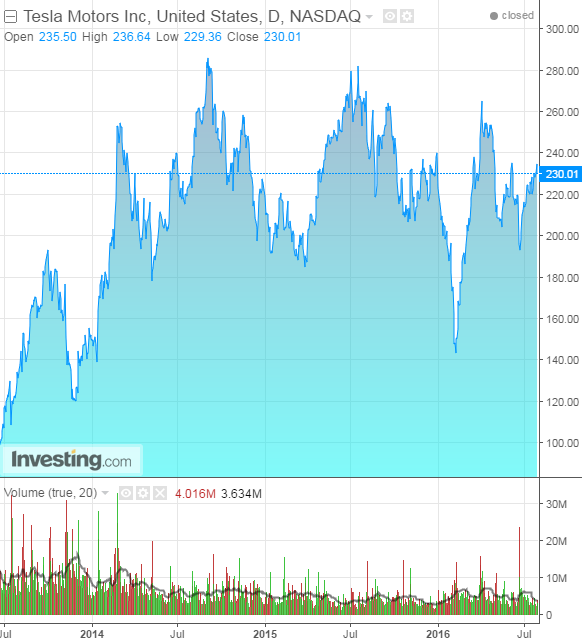by Clement Thibault
Tesla Motors Inc (NASDAQ:TSLA), the electric vehicle manufacturer, reports Q2 earnings on Wednesday, August 3, after the market closes.

1. Earnings and Revenue Forecast
The Wall Street consensus regarding Tesla is a negative EPS of $0.53 on $1.5B revenue. Compared to a year ago—when the company reported a negative EPS of $0.48 for Q2 '15—Tesla is expected to sink even deeper into negative EPS territory. Not that that's at all surprising. The company and its investors see themselves as still in the infrastructure-building phase of the business, a period when it is expected that expenses will outpace revenue. Which is especially true in capital-intensive industries such as the automotive or high tech sectors. And of course, Tesla belongs to both. Still, huge infrastructure investments don’t always translate to huge profits, and one question continues to dog the company—can Tesla actually deliver?
2. SolarCity Acquisition
On June 22nd, Tesla offered to buy SolarCity Corporation (NASDAQ:SCTY) in an all stock deal. Just yesterday Tesla agreed to the deal for less than originally proposed, but still quite rich at $2.6B. In essence, since Elon Musk is the largest shareholder with a 20% stake in each company, and chairman of both companies, he's offered the merger to himself. The transaction is now subject to shareholder approval. SolarCity is the largest solar energy systems provider in the residential market.
The acquisition, according to Musk, will allow Tesla to vertically integrate SolarCity's technology into the automaker's products. The deal has been roundly criticized by analysts, who believe Tesla did not have to expose itself to SolarCity's risks in order to achieve a strategic partnership in the solar panel industry. Before the acquisition, SolarCity faced stiff competition in its field from electric utilities and other solar panel firms, increasing its customer acquisition costs by 80% and seriously damaging the already money-losing company's viability.
Over the short term, the merger is supposed to save $150M in costs to both companies, with SolarCity benefiting from Tesla's brand recognition when it brings its solar products to market. Over the longer-term, Musk envisions an energy ecosystem, where all a customer's energy needs, whether at home or on the road, are supplied by Tesla affiliates.
3. Gigafactory
Musk's $5B "Gigafactory" opened in Nevada on July 29th. This arguably is the most important step Tesla has taken so far in order to achieve Musk's grand ambitions. According to architectural plans, this factory will become the largest building in the world by footprint, covering square footage equivalent to over 100 NFL football fields. But cosmetic details aside, the factory is critical to providing Tesla's cars with the batteries needed to power them. No Gigafactory, no mass production.
The funding for this monolith was recently secured when Panasonic (OTC:PCRFY), which is partnering with Tesla on this, stepped up and announced it would sell bonds in order to raise $3.8B, mostly to fund its part of the new factory. If all goes according to plan, Tesla will be able to produce 500K batteries a year in 2018, and should be able to produce 1.5M batteries at its peak. However that's quite a way off and of course the outcome remains uncertain.
4. Production
Tesla's production isn't exactly synonymous with efficient manufacturing. Its automobile factory in Northern California isn't keeping up with the company's planned pace. In the second quarter of 2016 Tesla delivered just 14,370 vehicles, against the 17,000 originally planned. While Tesla is undoubtedly ramping up its production when compared to last year's Q2—during which 11,530 cars were delivered—it is still uncertain when, and if, Tesla will ever be able to catch up to its own scheduling. While innovation and entrepreneurship are stronger than ever at Tesla, the company's ability to smoothly and successfully translate these ambitions into mass production—and more significantly serious revenue—remains unproven.
5. Start Big, Get Bigger?
Tesla, both the idea and the product, are potentially revolutionary. Tesla could change the way we produce and consume energy on a mass scale. Its projects, such as stopping climate change and self-driving cars, are certainly romantic, but Musk might just be a true visionary.
Unfortunately, ambitious ideas aren't always enough. It looks like Musk has decided to go big from the outset rather than wait for Tesla to grow at the pace that demand—and more importantly revenues—would dictate. Musk has obviously decided to go all in now...and let demand follow. That's nervy, but also incredibly risky.
Conclusion: While the demand for Tesla's Model 3 is indeed exceeding expectations, there is still a large gap between 350K pre-orders and actually having the capability to meet customer demand. Musk's hubris, along with Tesla's current inability to meet its own production numbers is worrying. At $230 a share, Tesla is very highly valuated. Its price-to-book ratio is 32, compared to the automobile industry P/B norm of under 2.
When a company reports negative earnings, most other metrics become irrelevant, but Tesla also has a negative cash flow. Tesla's current price is based solely on expectations, and we believe this price is being driven by an investor best case scenario even though there's no real proof it will ever come to fruition. Right now Tesla's efforts—car production, a huge factory, the acquisition of a struggling solar panel company—hardly guarantee certain success.
